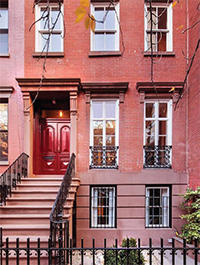Trending
Retirement & NYC real estate
Plan now and enjoy a hassle-free life later

One of the biggest aspects of retirement planning is figuring out what to do with real estate. In New York City, the equation is often exacerbated by the sheer value of the housing here, where a one-bedroom apartment can sell for $1 million or more. How do you pass along something like that to your heirs with minimal taxes? What about downsizing to a smaller place? And what about that second (or third) home, post-retirement?
Luxury Listings tracked down expert advice on how to retire well when it comes to real estate. It’s a topic confronting more and more New Yorkers, as twilight years become twilight decades, thanks to lifestyle changes and leaps in healthcare. In 2010, the life expectancy for a 40-year-old city resident was 82.3 years and, for a 70-year-old, 87 — both higher than the national averages of 80.5 and 85.5, respectively — suggesting that New Yorkers need above-average retirement planning.
It’s really all about planning ahead — however far off that end might seem today. Do the math now, experts say, and reap the benefits later. “As a financial planner, I know that many of my clients will be living into their 90s,” said Dina Lee, past board president of the Estate Planning Council of New York City. “It’s no longer a 10-year retirement plan. We’re talking about trying to make assets last 30-plus years.” Read on for our top tips.
Downsize
 Buying a smaller place can mean enjoying a financial windfall from the sale of a larger one. It will also reduce the amount you spend on bills — typically, in Manhattan, the larger the apartment, the higher the monthly common charges or maintenance fees.
Buying a smaller place can mean enjoying a financial windfall from the sale of a larger one. It will also reduce the amount you spend on bills — typically, in Manhattan, the larger the apartment, the higher the monthly common charges or maintenance fees.
Moreover, a sale of a larger residence can provide a tax advantage: Individuals are permitted to exclude from their federal income taxes up to $250,000 — $500,000 for married couples filing jointly — made on the sale of their primary residence (primary being the operative word here; read on for other types of properties).
Downsizing need not be about buying, either. Darla Delayne, head of referral and relocation for Coldwell Banker Bellmarc Group, has recently seen clients sell homes in areas just outside of the city. They pocket the profits and rent in New York instead. “They are putting that money aside for a couple of years and renting in the city,” she said, “and playing for a bit before they really make a decision on where they want to settle down.”
Adapt
 A 2012 AARP survey found that more than 80 percent of Americans want to stay in their homes as they grow old. Adding safety features to make a home aging-friendly is sometimes just a matter of a small tweak or two. For instance, in the kitchen, replace cabinet and drawer-pulls with handles instead of knobs, which can be harder on arthritic hands.
A 2012 AARP survey found that more than 80 percent of Americans want to stay in their homes as they grow old. Adding safety features to make a home aging-friendly is sometimes just a matter of a small tweak or two. For instance, in the kitchen, replace cabinet and drawer-pulls with handles instead of knobs, which can be harder on arthritic hands.
And, lest the cost of bigger renovations — like installing an elevator in a townhouse — spook you, know this: Investing in a major re-do now can save you big bucks down the line. A 2012 survey from insurance firm Genworth showed the benefits of renovating now for older age compared with the costs of assisted-living and nursing homes: The average monthly cost for an assisted-living facility in the U.S. was pegged at $3,200 — or nearly $40,000 annually.
Pass it on
Under the federal gift-tax exemption, anyone in their lifetime can pass up to $5.34 million of property without any federal taxes; married couples can pass up to twice this amount. Beyond the gift-tax exemption, deciding when to pass along real estate becomes a matter of looking at the cold, hard actuarial facts: Can you afford the home you’re in for as long as you live? And how valuable might it be at death versus selling it before you die?
“You look around and you realize you’re only using a few rooms of your home,” Lee said. “Is this really where you want to allocate capital to?” If housing costs are going to eat significantly into retirement savings — a good rule of thumb is that retirement spending shouldn’t exceed 5 percent of savings annually — then it may be time to downsize (see previous page) or pass on your residence.
In some cases — especially in New York City’s heated real estate market — it may be more worthwhile to pass on the asset at death. Experts suggest, however, hammering out terms of property bequeaths with condo and co-op boards at the time of purchase, whenever possible — rather than leaving relatives to deal with boards after your death.
Stay together
 A 2013 Pew Research analysis of Census data showed more than 16 percent of American households have at least two adult generations living under one roof. Also, the number of Certified Aging in Place Specialists (CAPS) designated by the National Association of Homebuilders has more than doubled since 2008, suggesting that the contracting industry is responding to an increased demand for multigenerational housing. The arrangement has myriad benefits, including having potential caretakers under one roof and allowing children to build up financial reserves in pursuit of their own home buys.
A 2013 Pew Research analysis of Census data showed more than 16 percent of American households have at least two adult generations living under one roof. Also, the number of Certified Aging in Place Specialists (CAPS) designated by the National Association of Homebuilders has more than doubled since 2008, suggesting that the contracting industry is responding to an increased demand for multigenerational housing. The arrangement has myriad benefits, including having potential caretakers under one roof and allowing children to build up financial reserves in pursuit of their own home buys.
You want a contractor with that CAPS designation, experts say, if you’re thinking of tricking out your home into a multigenerational habitat, in much the same way you’d want one for aging-in-place renovations. Transforming rooms into suites for privacy — with new bathrooms and entryways, for example — is typical of this type of renovation. Previously ignored spaces such as basements and garages often find new life as these suites.
Multigenerational homes generally work better in houses or townhouses. “I definitely see multigenerational in Brooklyn and Queens,” Delayne of Coldwell Banker Bellmarc said.
Play landlord
Sometimes, clients seek a multi-generational home that will eventually generate income through a rental component, Delayne said.
That’s one way of setting up shop as a landlord in retirement in New York City: When the kids — or grandkids — move out, the suite they inhabited becomes a rental. And that, experts say, opens up a toolbox of tax breaks, including deductions for interest payments related to loans for repairs or renovations.
Experts caution against large-scale apartment investments, unless you can afford them: The median sales price for an apartment building in the five boroughs in 2013 was $1.32 million, according to brokerage Massey Knakal. Costs such as repairs, insurance and a property manager — who will typically take a percentage of a building’s monthly rental revenue — can more than offset tax breaks, especially in the first years of ownership.
Enjoy a permanent vacation
 The same calculations that apply to your primary home apply to your secondary — or tertiary — one. You have to examine what you can afford, as well as the ease of commute between homes.
The same calculations that apply to your primary home apply to your secondary — or tertiary — one. You have to examine what you can afford, as well as the ease of commute between homes.
But there’s a twist that a lot of New Yorkers confront a few years into retirement.
Suppose that house in the country or that waterfront spread has become the place where you spend most of your time — in other words, your secondary home has become your primary. Tax law allows a married couple to exclude from federal taxation up to $500,000 in gains from selling a primary residence ($250,000 for individuals). Selling that vacation home that’s become a primary home can trigger that windfall, which can then be poured into buying another, less expensive place (see “Downsize”).
All the while, if you can afford it, you can keep your Manhattan pad as a secondary home.
Go part-time
If you have more than one residence, be aware of an expensive fact: Spending more than half a year at your New York City home makes you subject to the city’s income taxes, which also dip into estates and trusts. Experts advise that those who spend most of the year at their vacation homes maintain a paper trail to prove it come Tax Day. To crack down on city dwellers who might, in fact, be spending more time in town than they care to admit, New York in 2010 added an extra line to local tax forms, asking residents with secondary homes to specify how many days yearly they’re in Gotham.




